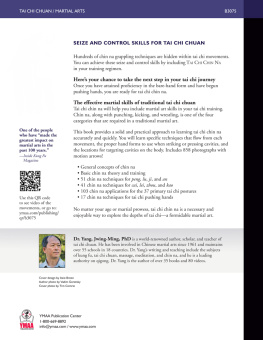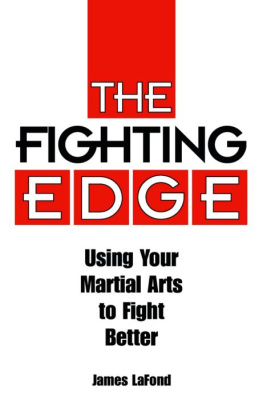Chen Taijiquan:
Masters and Methods

DAVIDINE SIAW-VOON SIM
& DAVID GAFFNEY

Copyright 2018 Davidine Siaw-Voon Sim & David Gaffney
All rights reserved.
ISBN: 1720938288
ISBN-13: 978-1720938286
FOR OUR PARENTS
CONTENTS
Acknowledgments
W e would like to thank the individuals featured in this book. Combined, they represent a remarkable repository of knowledge of which a work like this can only hope to scratch the surface. Their generosity in sharing hard-earned insights made it possible to write Chen Taijiquan: Master and Methods . It is important to record their understanding of the true nature of Chen Taijiquan, all of them having had a foot in an earlier time, before Taijiquan became a discipline for mass participation, and before teachers of the art became celebrities. This project has been ongoing for several decades and with an increasing sense of urgency as time gallops by. Sadly Master Feng Zhiqiang has now passed away and several of the others have experienced health issues highlighting the importance of documenting their unique and shared understanding of Chen Taijiquan. S everal of the masters articulated their desire to point out the correct way to train, so those coming after them can avoid errors they have made and deviations taken in their own journeys. Even with clear instructions, it is still the responsibility of learners to put in the necessary effort, transferring knowledge to practice and realising skill from intellectual understanding.
As far as possible we have recorded the words of the masters. There are certain areas of overlap and also much new material. For all their cooperation, encouragement and time, and for the inspiring calligraphy, a deep bow! Finally, a big thank you to all the talented artists who provided the illustrations.
Foreword
Honing gives a sharp edge to a sword; bitter cold adds keen fragrance to theplum blossoms.
This verse best describes the Taijiquan journey of Davidine Siaw-Voon Sim and David Gaffney these twenty plus years. In their search for authentic traditional Taijiquan, they came to Chenjiagou for the first time in the summer of 1997. In the ensuing years they continued to commit to arduous study and rigorous practice, coming to Chenjiagou every year, and have come to regard Chenjiagou, the birthplace of Taijiquan, as their second home. Resident in the UK, they have made it their mission to propagate Chinese culture and transmit Chen Taijiquan. Through their books, articles and blogs they have played a significant role in the transmission and spread of Chen Taijiquan.
Chen Xiaoxing
June 25 th2018



Honing gives a sharp edge to a sword; bitter cold adds keen fragrance to theplum blossoms.
Calligraphy by Du Min
Introduction
The origin of Chinese martial arts is antiquated, its traditional systems having undergone many centuries of evolution and refinement. For their continued survival, the most important factor is the uninterrupted transmission of skill, knowledge and practice methods from master to disciple: Masters having grasped the essence of their respective art through years of apprenticeship and long study and practice; Disciples, receiving the baton and following on in the same manner to ensure the continuity and endurance of the art. The more standard and complete the transmission the greater the likelihood of its continued existence. Historically it was acknowledged that failing to honour your master is to invoke the wrath of heaven and earth; misleading your students is to be worse than thieves and whores! The words may seem harsh but they illustrate the importance of a correct relationship between teacher and student. A person's quan - literally fist, meaning martial practice - invariably contains not only the physical shape but also the mind of the teacher. Some masters transmit movements and routines, others transmit techniques and skill. The best masters also transmit the spirit and soul of their art. Beyond techniques and skills of movements and routines, the broader origins of the martial arts can be glimpsed through their teaching. At the highest level, serving as a torch that can light the pathway to an earlier form of knowledge. Martial arts are physical conduits through which to study and understand a culture and provide a route to accessing its wisdom.
Taijiquan is one of Chinas ancient martial arts. Yet in the twenty-first century few arts are more misunderstood than Taijiquan. In the world of martial arts cinema, masters are portrayed as almost superhuman individuals capable of defeating opponents with little more than a touch, or with no touch at all! Alternatively, it is perceived as a kind of esoteric slow motion health exercise practised in public parks by mostly elderly Chinese people, or as some kind of religious or pseudo-spiritual practice. Many people are attracted by its overt displays and aesthetic expressions in competitions and public performances. All of these perceptions are far removed from what Taijiquan really is. In the past, exponents trained seriously and quietly behind the high walls typical of traditional Chinese houses . Today, people who undertake Taijiquan as a hobby, as a sport, or as an exercise to maintain fitness, often seek the perfect environment and personal circumstances in order to train. Erroneous perceptions of what Taijiquan is often leading people to force the art to fit their misperceptions. To be fair, practitioners are often handicapped by a scarcity of accurate information on the art and the stranglehold of established narratives. That a martial arts system may be used for combat purposes should hardly come as a surprise, but this reality is downplayed if not completely lost in many contemporary conversations that focus exclusively on its health and spirituality aspects .
The primary goal of Chen Taijiquan: Masters and Methods is to attempt to refute some of the more pervasive stereotypes and address some of the more substantive questions regarding the systems philosophy and methodology. It explores the nature of Chen Taijiquan, presenting a collection of authoritative viewpoints documenting the experiences and insights of some of the arts foremost elder practitioners. As far as possible trying to present an accurate picture of Chen Taijiquan as it was passed down by previous generations. The masters interviewed in the following pages represent an important link to an earlier period when the process of acquiring high level Taijiquan skills was pursued without any promise of financial reward or global recognition. Most knowledgeable observers would agree that subsequent generations of practitioners have yet to attain the standards of those featured within. This, despite the fact that todays emerging Taijiquan players never had to experience the grinding poverty, natural disasters and political turbulence their predecessors faced.
The masters featured provide a tangible bridge to the past generations of practitioners who experienced Taijiquan as much more than a leisure pursuit. Today China is peaceful and prosperous, but just one generation before their predecessors were called upon to us e Taijiquan to defend themselves and their communities from real threats. Stories are still recounted of life and death encounters: in their roles as
Next page











